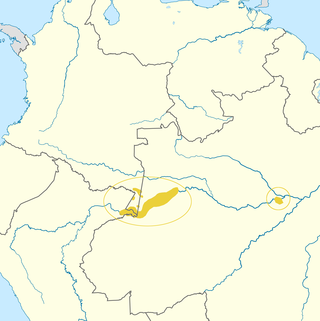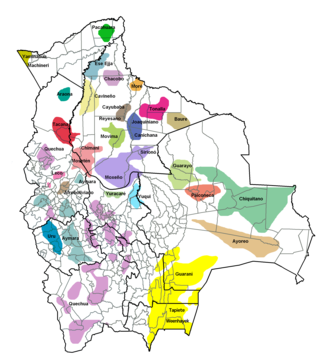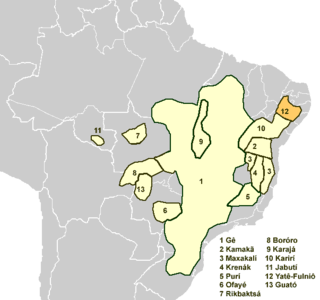A syllable is a unit of organization for a sequence of speech sounds typically made up of a syllable nucleus with optional initial and final margins. Syllables are often considered the phonological "building blocks" of words. They can influence the rhythm of a language, its prosody, its poetic metre and its stress patterns. Speech can usually be divided up into a whole number of syllables: for example, the word ignite is made of two syllables: ig and nite.

Pangasinan (Pangasinense) is an Austronesian language, and one of the eight major languages of the Philippines. It is the primary and predominant language of the entire province of Pangasinan and northern Tarlac, on the northern part of Luzon's central plains geographic region, most of whom belong to the Pangasinan ethnic group. Pangasinan is also spoken in southwestern La Union, as well as in the municipalities of Benguet, Nueva Vizcaya, Nueva Ecija, and Zambales that border Pangasinan. A few Aeta groups and most Sambal in Central Luzon's northern part also understand and even speak Pangasinan as well.
A.tong is one of the Garo dialect Sino-Tibetan language which is also related to Koch, Rabha, Bodo other than Garo language. It is spoken in the South Garo Hills and West Khasi Hills districts of Meghalaya state in Northeast India, southern Kamrup district in Assam, and adjacent areas in Bangladesh. The correct spelling "A.tong" is based on the way the speakers themselves pronounce the name of their language. There is no glottal stop in the name and it is not a tonal language.

Ticuna, Tikuna, Tucuna or Tukuna is a language spoken by approximately 50,000 people in the Amazon Basin, including the countries of Brazil, Peru, and Colombia. It is the native language of the Ticuna people and is considered "stable" by ethnologue. Ticuna is generally classified as a language isolate, but may be related to the extinct Yuri language and there has been some research indicating similarities between Ticuna and Carabayo. It is a tonal language, and therefore the meaning of words with the same phonemes can vary greatly simply by changing the tone used to pronounce them.
Itonama is a moribund or extinct language isolate once spoken by the Itonama people in the Amazonian lowlands of north-eastern Bolivia. It was spoken on the Itonomas River and Lake in Beni Department.

Tiipai (Tipay) is a Native American language belonging to the Delta–California branch of the Yuman language family, which spans Arizona, California, and Baja California. As part of the Yuman family, Tiipai has also been consistently included in the controversial quasi-stock Hokan. Tiipai is spoken by a number of Kumeyaay tribes in northern Baja California and southern San Diego County, California. There were, conservatively, 200 Tiipai speakers in the early 1990s; the number of speakers has since declined steadily, numbering roughly 100 in a 2007 estimate.
Chiquitano is an indigenous language isolate spoken in the central region of Santa Cruz Department of eastern Bolivia and the state of Mato Grosso in Brazil.
Debuccalization or deoralization is a sound change or alternation in which an oral consonant loses its original place of articulation and moves it to the glottis. The pronunciation of a consonant as is sometimes called aspiration, but in phonetics, aspiration is the burst of air accompanying a stop. The word comes from Latin bucca, meaning "cheek" or "mouth".

Canichana, or Canesi, Joaquiniano, is a possible language isolate of Bolivia. In 1991 there were 500 Canichana people, but only 20 spoke the Canichana language; by 2000 the ethnic population was 583, but the language had no L1 speakers left.
The phonology of the Zuni language as spoken in the southwestern United States is described here. Phonology is a branch of linguistics that studies how languages or dialects systematically organize their sounds.
Irántxe /iˈɻɑːntʃeɪ/, also known as Mỹky (Münkü) or still as Irántxe-Münkü, is an indigenous language spoken by the Irántxe and Mỹky peoples in the state of Mato Grosso in Brazil. Recent descriptions of the language analyze it as a language isolate, in that it "bears no similarity with other language families". Monserrat (2010) is a well-reviewed grammar of the language.

Harakmbut or Harakmbet is the native language of the Harakmbut people of Peru. It is spoken along the Madre de Dios and Colorado Rivers, in the pre-contact country of the people. There are two dialects that remain vital: Amarakaeri (Arakmbut) and Watipaeri (Huachipaeri), which are reported to be mutually intelligible. The relationship between speakers of the two dialects is hostile.
The Kaingang language is a Southern Jê language spoken by the Kaingang people of southern Brazil. The Kaingang nation has about 30,000 people, and about from 60% to 65% speak the language. Most also speak Portuguese.
Tundra Nenets is a Uralic language spoken in European Russia and North-Western Siberia. It is the largest and best-preserved language in the Samoyedic group.

Fulniô, or Yatê, is a language isolate of Brazil, and the only indigenous language remaining in the northeastern part of that country. The two dialects, Fulniô and Yatê, are very close. The Fulniô dialect is used primarily during a three-month religious retreat. Today, the language is spoken in Águas Belas, Pernambuco.

Siona is a Tucanoan language of Colombia and Ecuador. The language is essentially the same as Secoya, but speakers are ethnically distinct.
Stieng is the language of the Stieng people of southern Vietnam and adjacent areas of Cambodia, and possibly Laos. Along with Chrau and Mnong, Stieng is classified as a language of the South Bahnaric grouping of the Mon–Khmer languages within the Austroasiatic language family. In the Austroasiatic scheme, the Bahnaric languages are often cited as being most closely related to the Khmer language.

Ilocano is an Austronesian language spoken in the Philippines, primarily by Ilocano people and as a lingua franca by the Igorot people and also by the native settlers of Cagayan Valley. It is the third most-spoken native language in the country.

Matlatzinca, or more specifically San Francisco Matlatzinca, is an endangered Oto-Manguean language of Western Central Mexico. The name of the language in the language itself is pjiekak'joo. The term "Matlatzinca" comes from the town's name in Nahuatl, meaning "the lords of the network." At one point, the Matlatzinca groups were called "pirindas," meaning "those in the middle."

The Jesuit Missions of Moxos are located in the Llanos de Moxos of Beni department in eastern Bolivia. Distinguished by a unique fusion of European and Amerindian cultural influences, the missions were founded as reductions or reducciones de indios by Jesuits in the 17th and 18th centuries to convert local tribes to Christianity.










